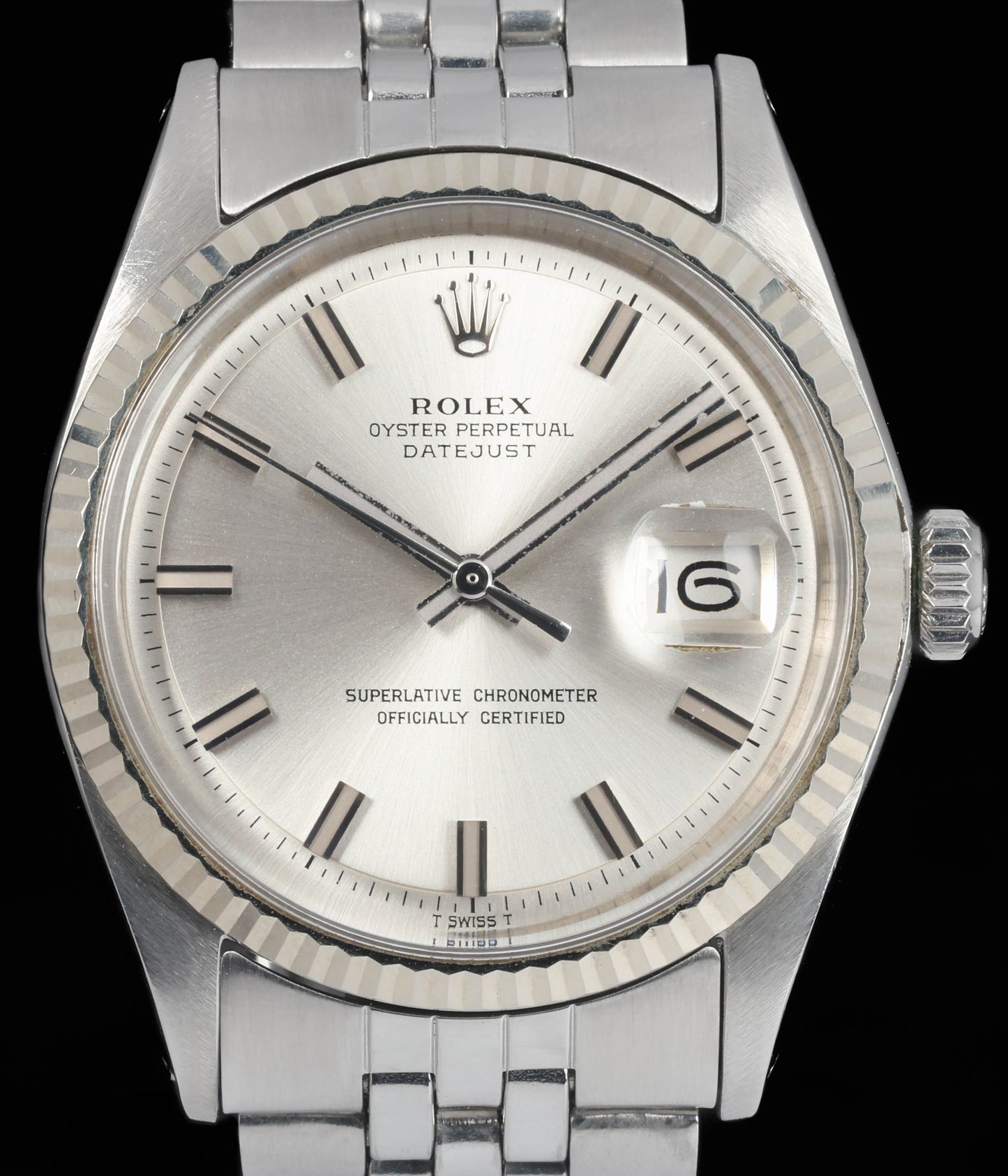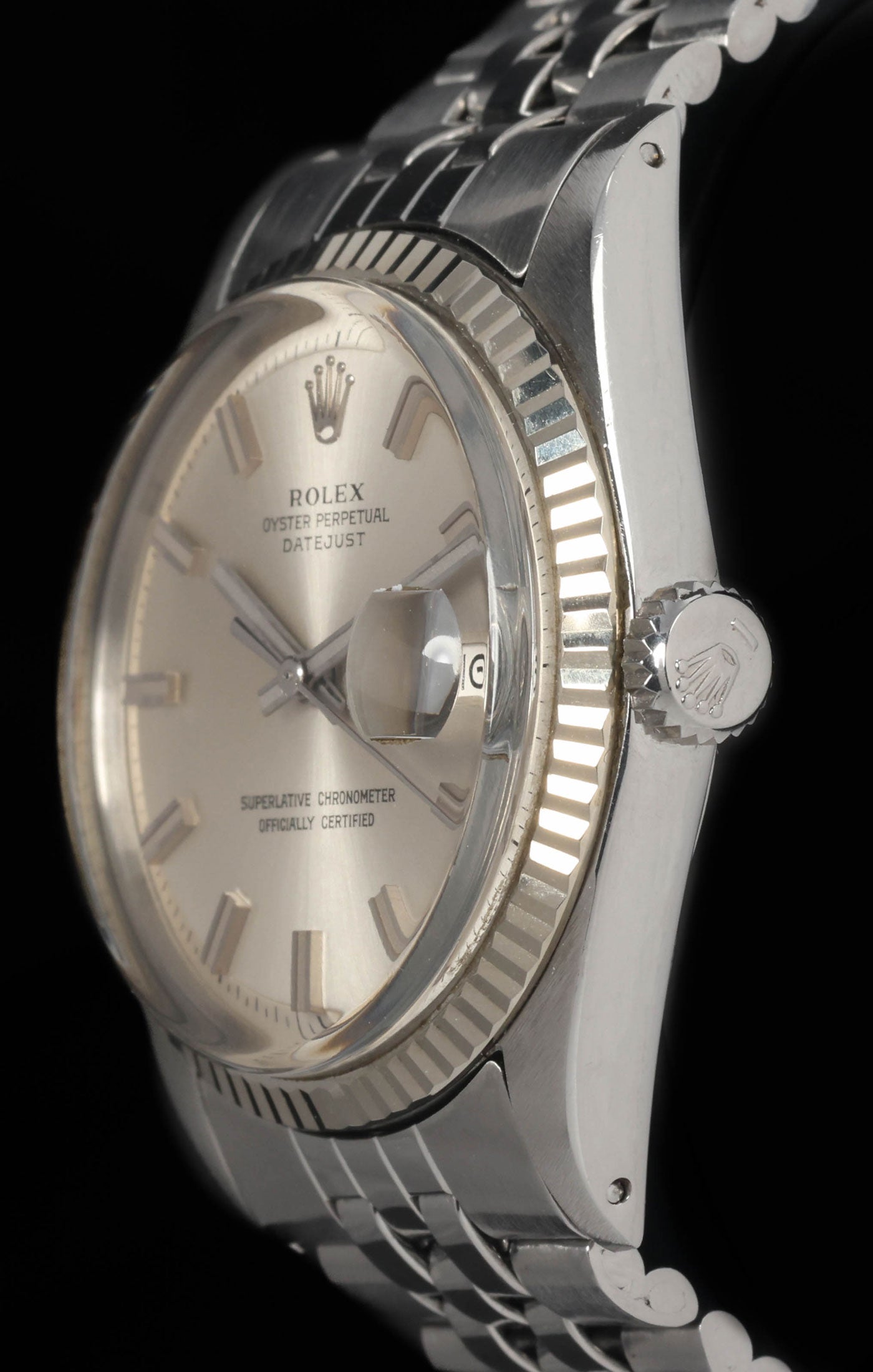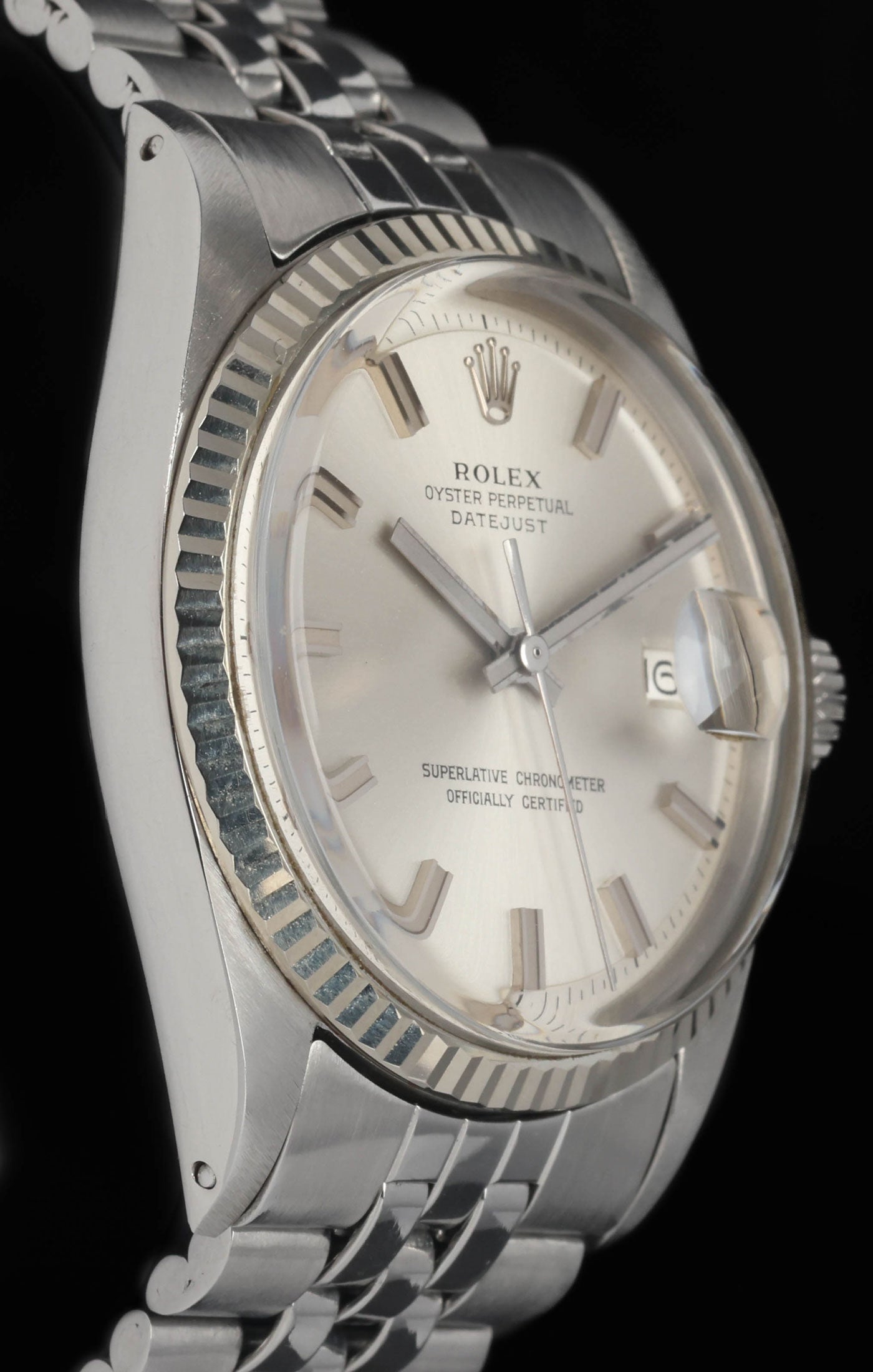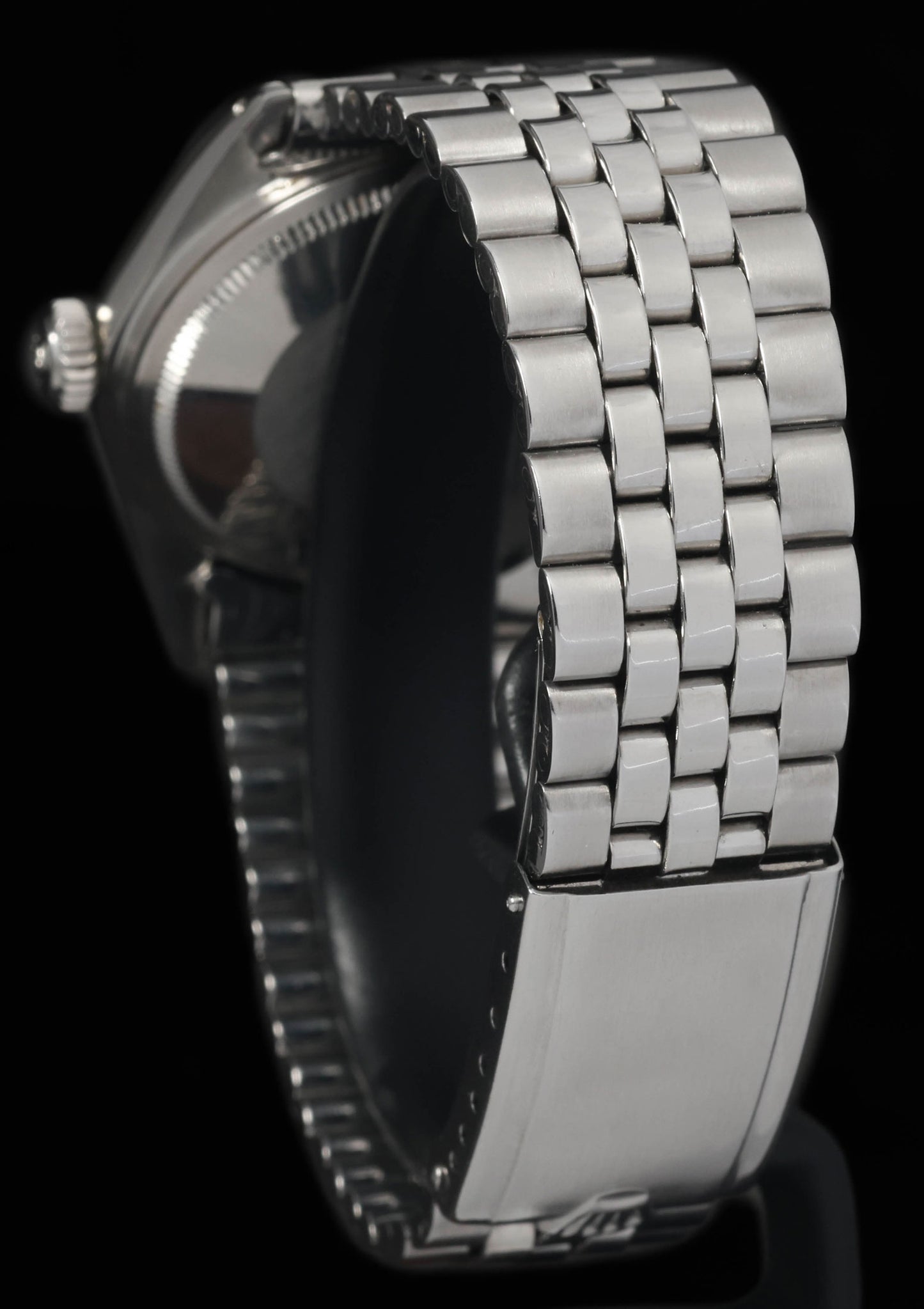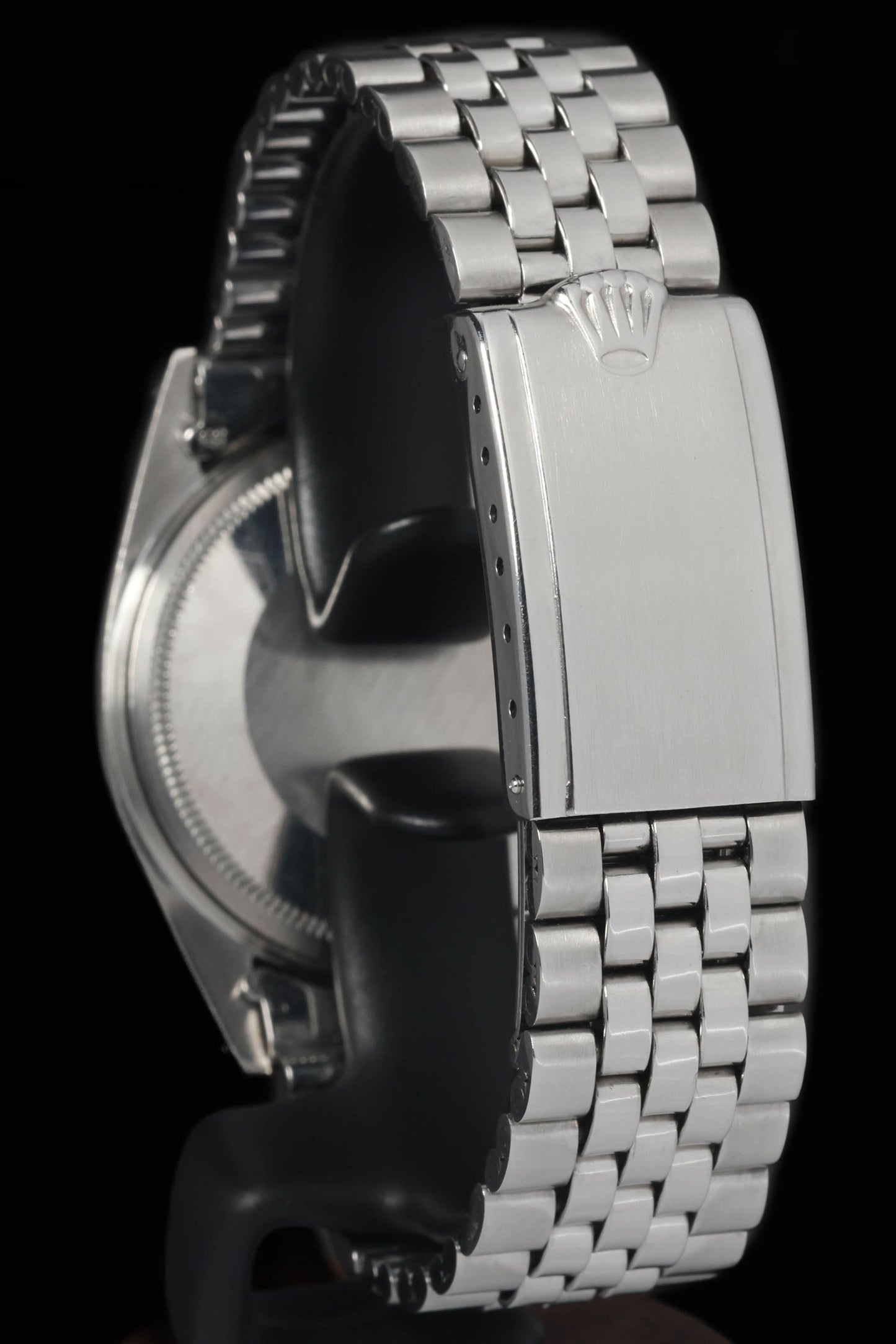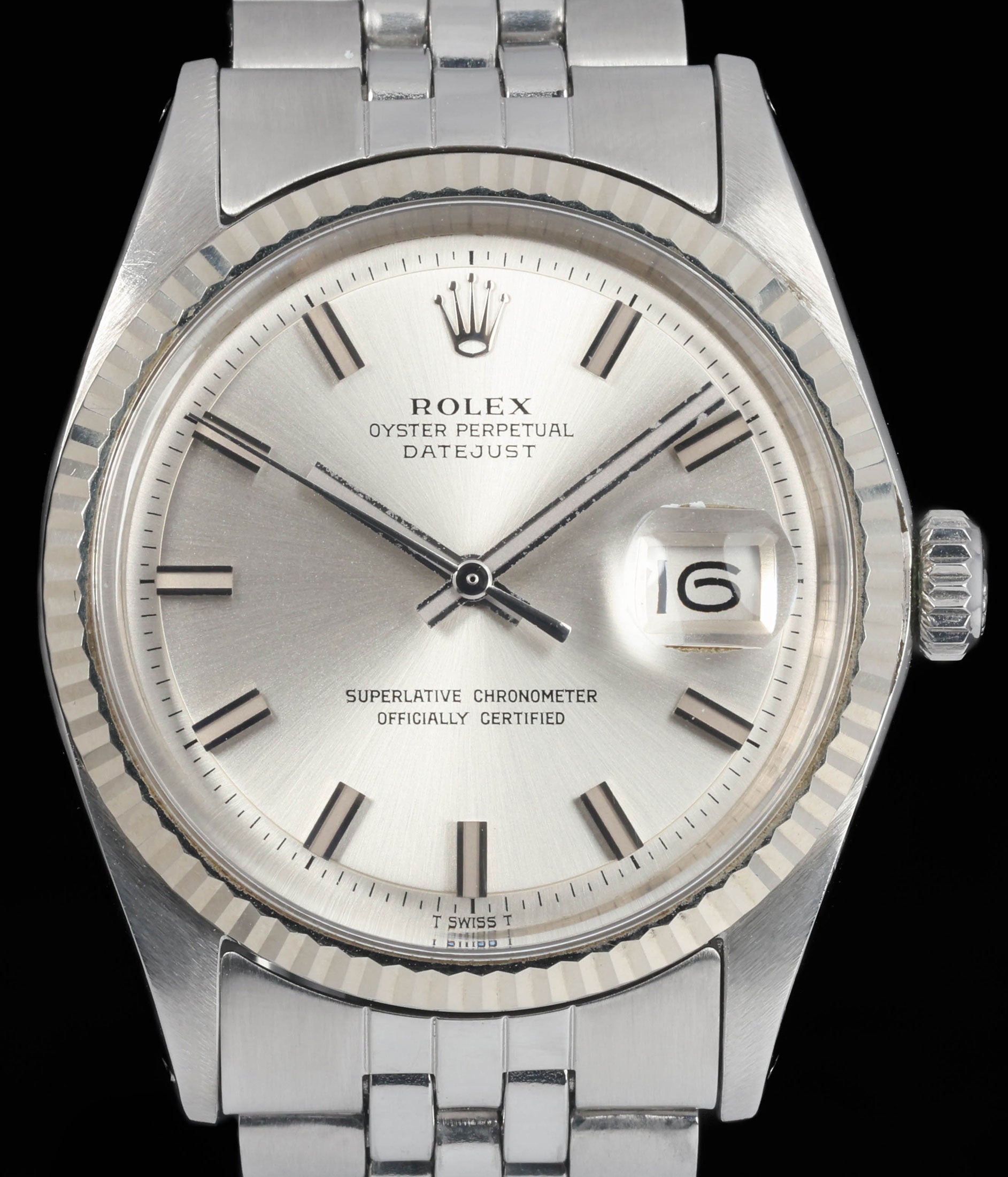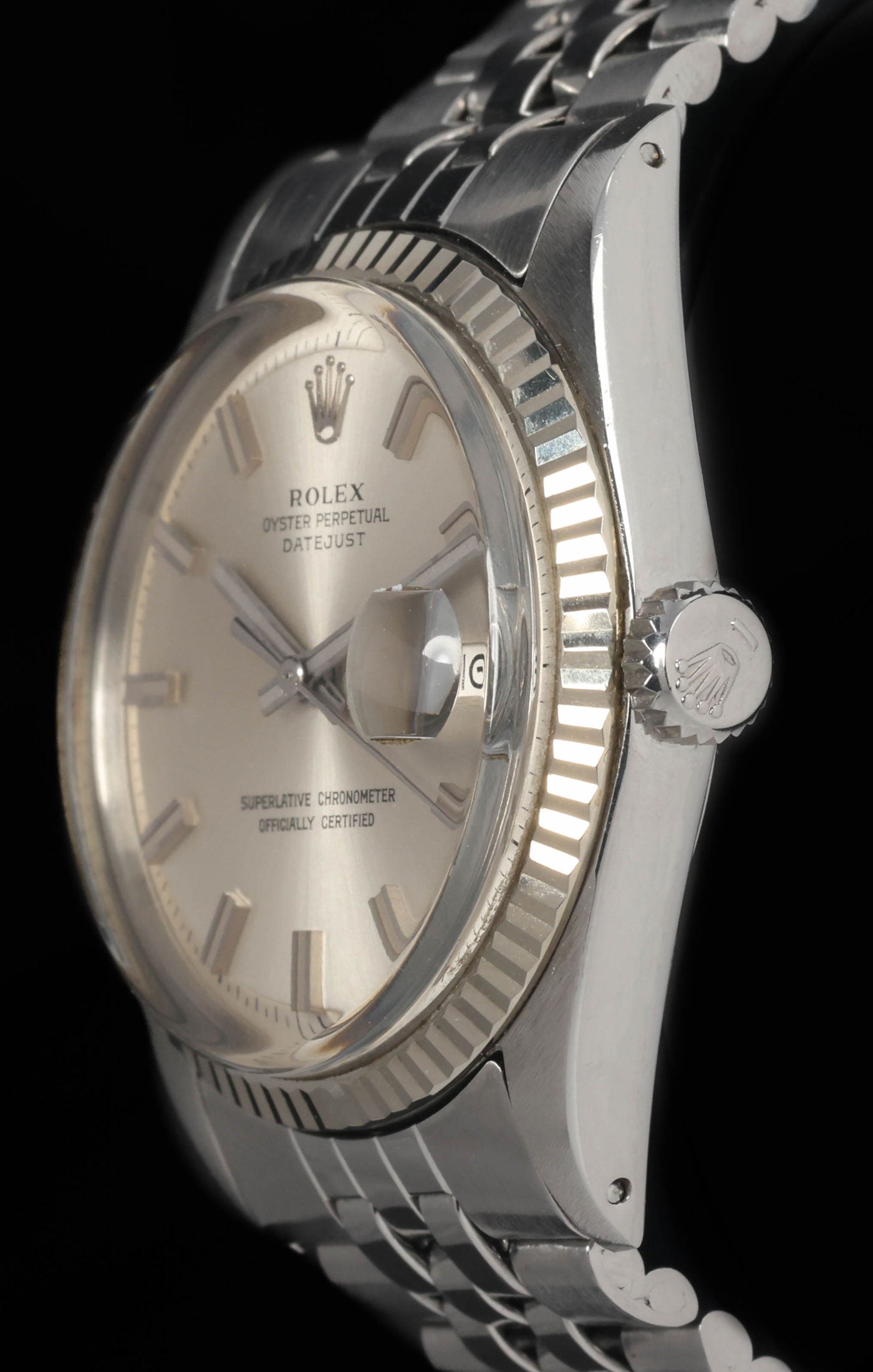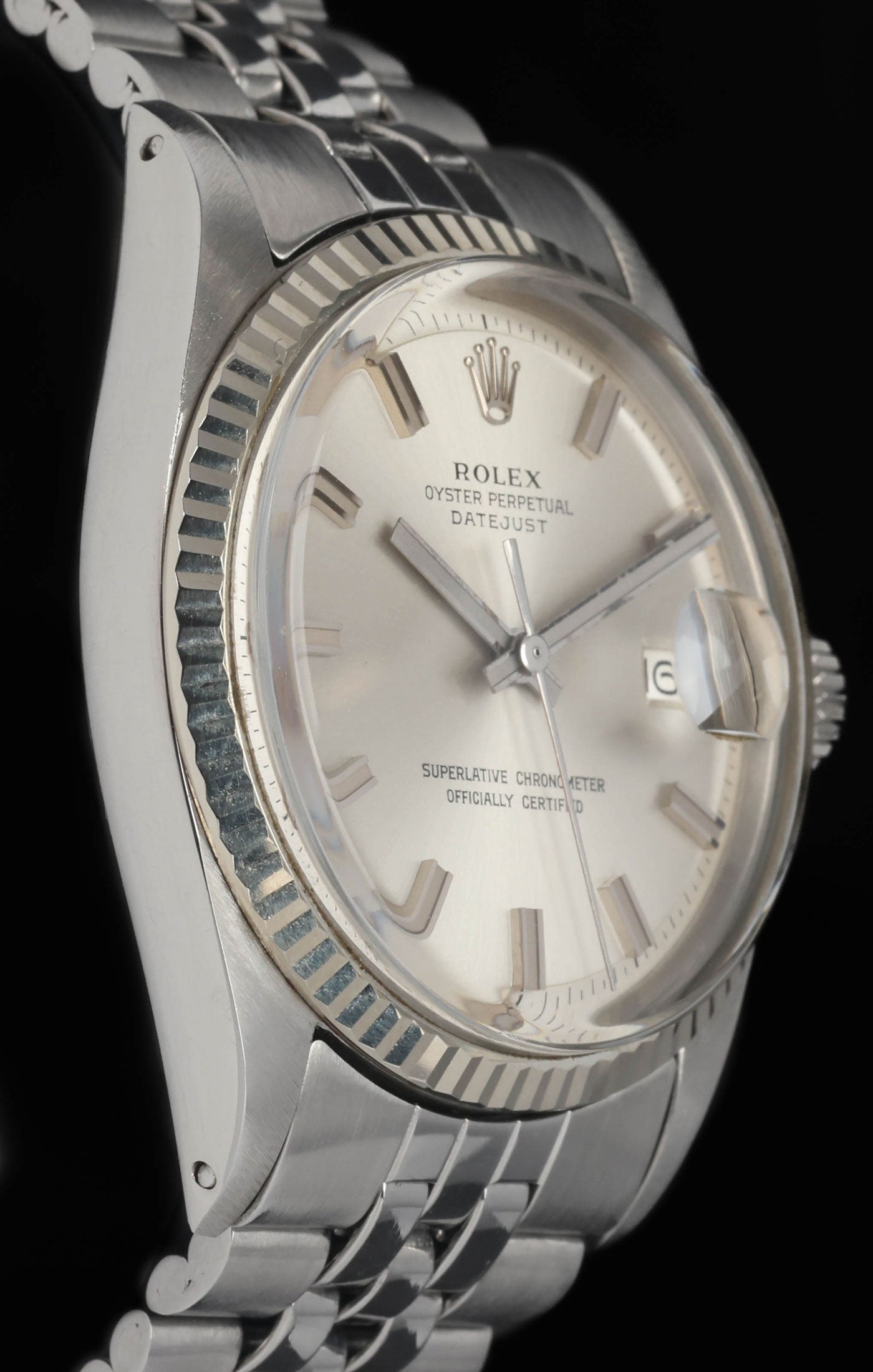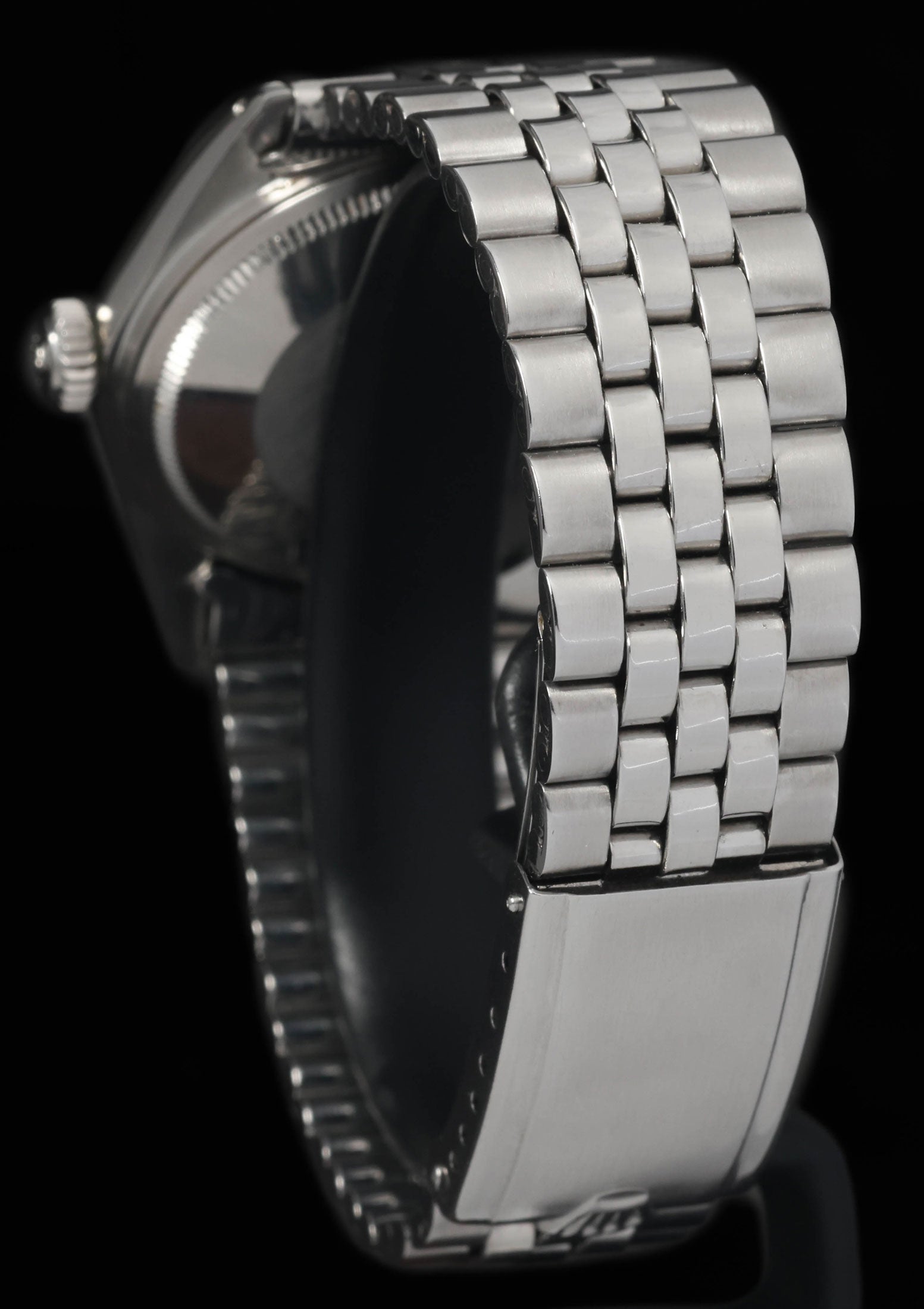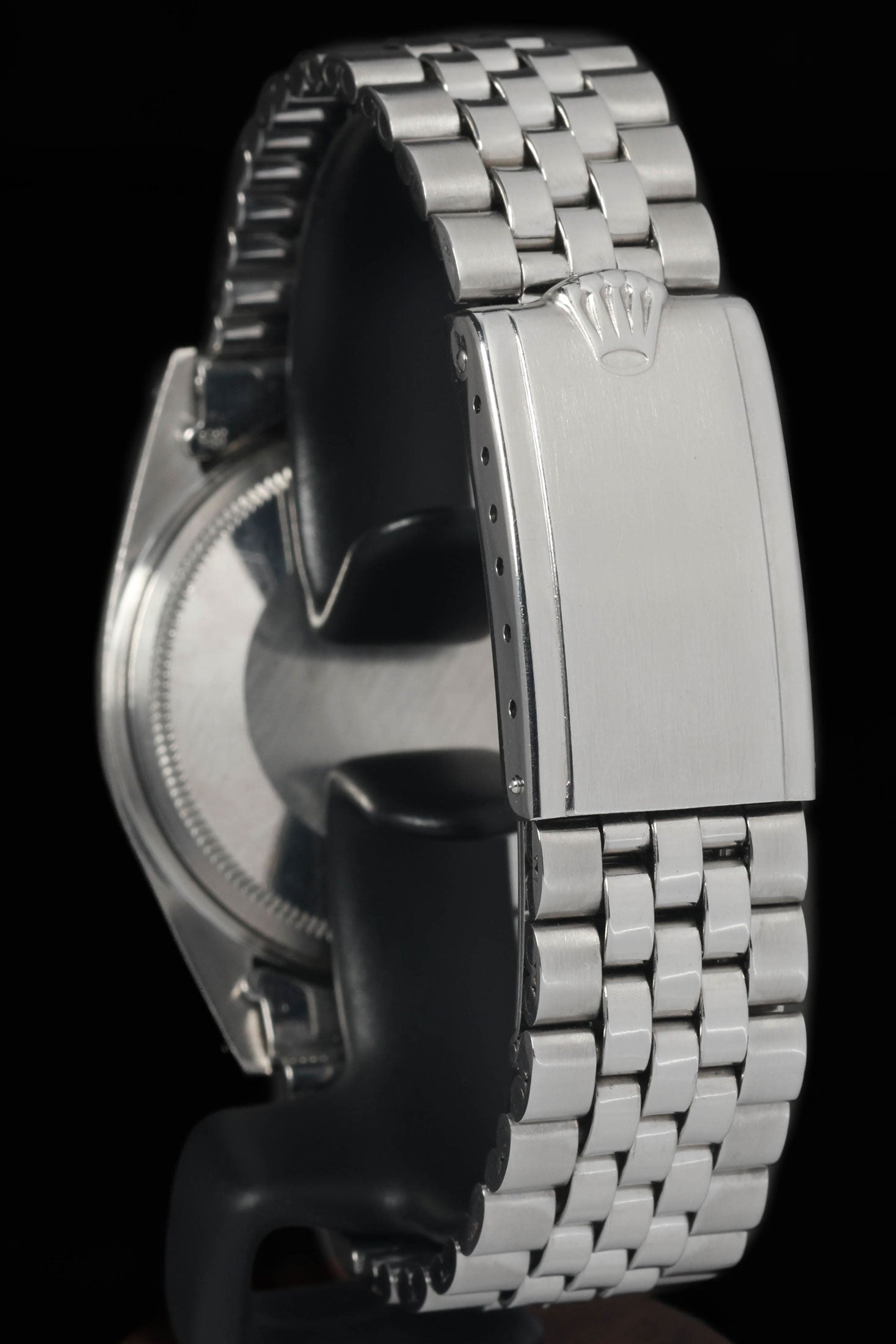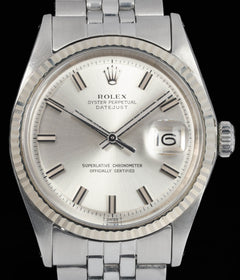Crown Vintage
Rolex Datejust 1601 'Wide-Boy' 36mm 1971
Rolex Datejust 1601 'Wide-Boy' 36mm 1971
Couldn't load pickup availability
Rolex Datejust 1601 'Wide-Boy' 36mm 1971
Case of this Rolex Datejust 1601 Wide-Boy is in very good vintage condition, showing little to no wear visible to the naked eye. The white gold fluted bezel retains its sharp definition, while the stainless steel case exhibits strong, well-preserved lugs with factory brushing still apparent. Bracelet remains in excellent condition with minimal stretch, maintaining a firm and comfortable fit on the wrist. The distinctive Wide-Boy dial presents in very good condition with crisp printing and beautifully aged hour markers. Hands display light oxidation consistent with age, complementing the overall vintage character. This is a superb example of the iconic 1601 Wide-Boy configuration, retaining originality and period charm. As with all vintage timepieces, it should not be worn while swimming, even though the Datejust line was originally built with water resistance.
Share
Why we love this watch
Why we love this watch
Rolex Datejust 1601 ‘Wide-Boy’ 36MM 1971
Introduction
The Rolex Datejust 1601 is one of the brand’s most enduring designs, combining functionality with timeless form. Within this long lineage, the “Wide-Boy” variant stands out for its distinctive dial and handset, both featuring unusually broad markers and hands. Produced briefly in the early 1970s, this configuration gave the familiar Datejust a more assertive character while retaining the balanced proportions that define Rolex’s mid-century design language. The 1601 Wide-Boy captures a specific point in Rolex history when the brand experimented subtly with aesthetic variations without departing from its core principles of precision, reliability and restrained luxury.
Origins of the Datejust
Introduced in 1945 for Rolex’s 40th anniversary, the Datejust was the world’s first self-winding chronometer wristwatch to feature a date window that changed automatically at midnight. This innovation set a new standard for everyday utility. The model debuted with the Jubilee bracelet and the Oyster case, both of which became integral to Rolex’s identity. Over the following decades, the Datejust evolved through incremental improvements rather than major redesigns. Early references with bubble-back cases and domed crystals gradually gave way to flatter profiles and more robust movements. By the 1960s, the Datejust had become synonymous with understated refinement and mechanical excellence.
Reference 1601: The Classic Datejust
The reference 1601 represents the definitive mid-century Datejust. It was introduced in the early 1960s and produced for roughly a decade. The model featured a 36mm stainless steel Oyster case with an 18k white gold fluted bezel, creating a subtle two-tone effect. It was available on either a Jubilee or Oyster bracelet, both period-correct in their folded-link construction. Inside the case was the Calibre 1570 automatic movement, a highly reliable chronometer-grade calibre equipped with a free-sprung balance and Microstella regulation system. The pie-pan dial with its gently sloping edge, together with the magnified date window at three o’clock, gave the 1601 the distinctive depth and balance that have made the Datejust instantly recognisable.
The ‘Wide-Boy’ Dial
The “Wide-Boy” designation refers to a distinctive dial and handset variation found on a small number of Datejust and Day-Date watches from the late 1960s to the early 1970s. The term is informal and was not used by Rolex itself. On these models, the applied hour markers are noticeably wider than usual, and the hands are proportioned to match. The result is a stronger visual presence, giving the dial a more geometric and assertive appearance. On the 1601, these dials were typically produced in silver, champagne or grey sunburst finishes, though a few examples in blue and black are known. Tritium lume plots sit neatly at the ends of the hour markers, indicated by the “T SWISS T” marking at the base of the dial. The Wide-Boy layout strikes a rare balance between boldness and restraint, maintaining the Datejust’s elegance while adding a subtle sense of depth and weight.
Case and Construction
The 1601 Wide-Boy shares the same case structure as standard examples of the reference. The 36mm stainless steel case is complemented by a fluted bezel in 18k white gold. The Oyster case, introduced decades earlier, was a major advancement in watch design, combining a screw-down crown, caseback and crystal to achieve genuine water resistance. When new, the 1601 was rated to 100 metres, sufficient for everyday wear. The crystal is acrylic, which gives the watch a warm, vintage aesthetic distinct from the harder reflections of modern sapphire. The domed crystal slightly distorts the dial at the edges, adding charm to its presentation. A cyclops lens magnifies the date window at three o’clock, a feature first introduced in the 1950s. The fluted bezel catches the light from every angle, giving the watch its unmistakable sparkle. The case alternates between polished and brushed surfaces, and depending on configuration, was fitted with either the Jubilee bracelet for a dressier look or the Oyster bracelet for a sportier character.
Movement: Calibre 1570
The Calibre 1570 is regarded as one of Rolex’s most reliable automatic movements. Operating at 19,800 vibrations per hour, it features a free-sprung balance, Breguet overcoil hairspring and bi-directional rotor. The movement was chronometer-certified and capable of maintaining exceptional accuracy under a wide range of conditions. It did not yet feature the quickset date function introduced in later models, but the date change was instantaneous and highly precise. The Calibre 1570 set the benchmark for mechanical reliability during the era, and its architecture formed the basis for Rolex movements that followed. Even today, examples that have been properly serviced continue to perform to a high standard.
Historical Significance
The early 1970s were a pivotal time for Rolex and for watchmaking more broadly. The quartz revolution was beginning to reshape the industry, yet Rolex continued to refine its mechanical calibres. The 1601 Wide-Boy emerged during this period of quiet confidence. It represents Rolex at its most assured, continuing to perfect the automatic wristwatch while subtly experimenting with design. The Wide-Boy dial stands as one of the few stylistic variations that broke from the standard Datejust format without compromising legibility or function. It was an understated departure, one that gave the model a distinct visual identity while remaining unmistakably a Rolex.
Dial Variations and Finishing
While the Wide-Boy dial is defined primarily by its oversized markers, there are subtle differences among surviving examples. Most feature sunburst finishes that radiate from the centre, creating a play of light under different angles. The applied hour markers are flat-topped and bordered with polished metal. The hands are rectangular and carry matching lume, ensuring balanced proportions between the two elements. The “ROLEX OYSTER PERPETUAL DATEJUST” and “SUPERLATIVE CHRONOMETER OFFICIALLY CERTIFIED” text is finely printed, typically in black. The coronet at 12 o’clock is sharply formed, reflecting the meticulous finishing standards of the period. These dials embody the craftsmanship and attention to detail that made Rolex a leader in serial watch production.
Proportions and Wearability
At 36mm, the 1601 remains a versatile size suitable for both formal and casual wear. The wide hour markers and thicker hands give the dial a slightly bolder look than standard Datejust models, but the overall aesthetic remains balanced. The fluted bezel frames the dial perfectly, while the domed crystal softens its edges. On the wrist, the watch wears elegantly and sits comfortably thanks to the curved lugs and light bracelet construction. The folded-link Jubilee bracelet contributes to its vintage feel, offering a combination of suppleness and lightness that later solid-link bracelets do not replicate. The result is a watch that feels understated yet substantial.
The 1601 in Context
The 1601 was part of a trio of Datejust references that defined the period. The 1600 featured a smooth bezel, the 1603 an engine-turned bezel, and the 1601 the fluted white-gold bezel. Together they provided subtle variations to suit different tastes. The Wide-Boy configuration appeared primarily on the 1601 and on select Day-Date references such as the 1803. Its production run was short, limited to the late 1960s and early 1970s, making it one of the less common dial variants. The reference as a whole remained in production until it was succeeded by the 16014, which introduced the quickset feature and sapphire crystal. The 1601 Wide-Boy therefore represents the last of the traditional Datejusts before Rolex modernised the line.
Construction and Finishing
During this era, Rolex maintained a high level of hand-finishing even in mass production. The cases were milled from solid stainless steel and fitted with individually machined white-gold bezels. The fluting was cut sharply, producing the signature reflective effect that changes under light. The dials were made using layered printing and radial brushing techniques to achieve the distinctive sunburst finish. The folded-link bracelets, although lighter than modern ones, offered flexibility and comfort. The construction quality ensured that even after decades of wear, many examples remain in strong condition.
Reliability and Care
The 1601 was designed for durability, and its Calibre 1570 movement has a reputation for longevity. However, as with all vintage watches, its water resistance should no longer be relied upon. The watch should be treated as a vintage timepiece and not worn while swimming or exposed to moisture. The acrylic crystal can be polished easily, and replacement parts remain available, allowing these watches to be maintained in excellent working order. When properly serviced, the movement continues to perform accurately and reliably.
The Rolex Landscape in the Early 1970s
By the early 1970s, Rolex was solidifying its identity as both a luxury brand and a maker of precision tools. The company’s professional models such as the Submariner, GMT-Master and Explorer had achieved iconic status, while the Datejust remained its flagship civilian model. It was the watch that bridged business, travel and daily life. Rolex’s advertising during this period emphasised achievement and reliability, aligning the brand with success and dependability. The 1601 Wide-Boy fits perfectly within that context. It is refined yet practical, luxurious without ostentation.
Enduring Legacy
The Wide-Boy dial variation had a quiet but lasting influence on later Rolex design. The emphasis on legibility and proportion carried through to other models, including certain Day-Date and Oyster Perpetual references that adopted wider markers in subsequent decades. Today, the 1601 Wide-Boy stands out as one of the most recognisable vintage Datejust configurations. Its distinctive dial layout, robust movement and balanced proportions capture the essence of Rolex design at a moment when the brand was refining rather than reinventing.
Final Thoughts
The Rolex Datejust 1601 Wide-Boy from 1971 represents an important chapter in the company’s evolution. Its combination of the Calibre 1570 movement, 36mm Oyster case and bold dial design exemplifies the precision and craftsmanship of Rolex during the early 1970s. The wide hour markers give the watch its unique character while maintaining the elegance that defines the Datejust line. With its fluted white-gold bezel, sunburst dial and enduring mechanical reliability, the 1601 Wide-Boy remains one of the most compelling examples of Rolex’s ability to innovate within tradition. It stands as a refined, technically sound and historically significant vintage timepiece that continues to reflect the brand’s enduring design principles.
Case & Bracelet
Case & Bracelet
Case in very good vintage condition. Little to no wear is visible. Bracelet in excellent condition with little to no stretch visible.
Dial & Hands
Dial & Hands
Dial and hands in very good condition with light oxidation on hands.
Warranty & Condition
Warranty & Condition
Crown Vintage Watches provides a minimum 3-month mechanical warranty on pre-owned watches, from the date of purchase.
The warranty covers mechanical defects only.
The warranty does not cover damages such as scratches, finish, crystals, glass, straps (leather, fabric or rubber damage due to wear and tear), damage resulting from wear under conditions exceeding the watch manufacturer’s water resistance limitations, and damage due to physical and or accidental abuse.
Please note, water resistance is neither tested nor guaranteed.
Shipping and insurance costs for warranty returns to us must be covered by the customer. Returns must be shipped via traceable courier. Return shipment must be pre-paid and fully insured. Collect shipping will be refused. In case of loss or damages, the customer is liable.
Our Pledge
At Crown Vintage Watches, we stand by the authenticity of every product we sell. For added peace of mind, customers are welcome to have items independently authenticated at their own expense.
Condition
Due to the nature of vintage timepieces, all watches are sold as is. We will accurately describe the current condition and working order of all watches we sell to the best of our ability.
Shipping & Refund
Shipping & Refund
